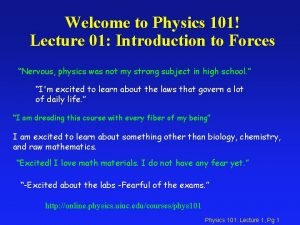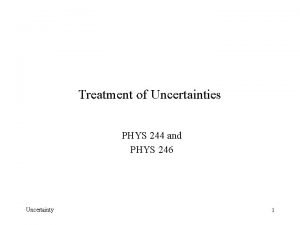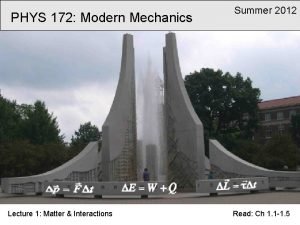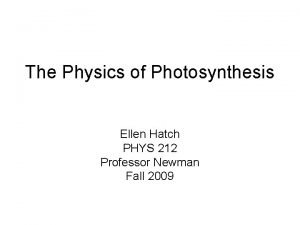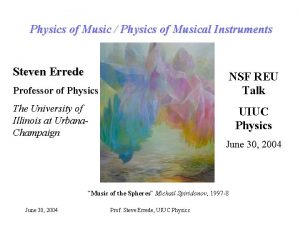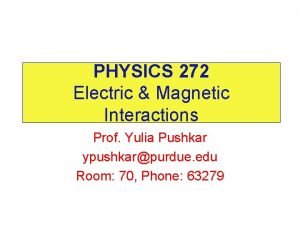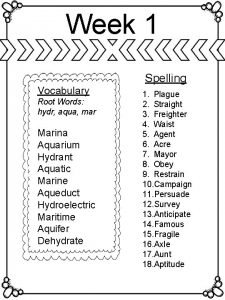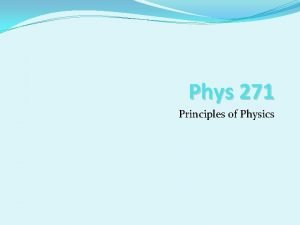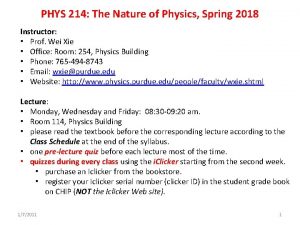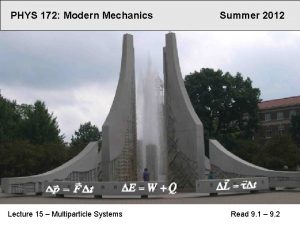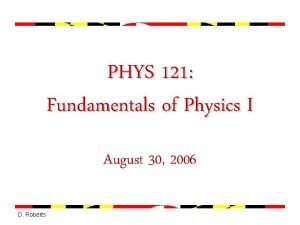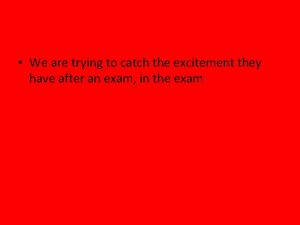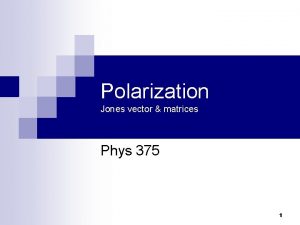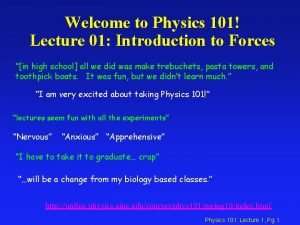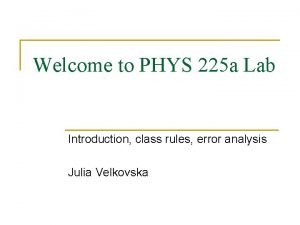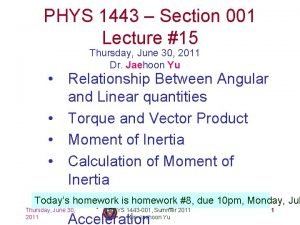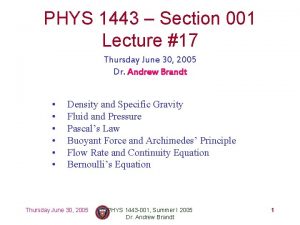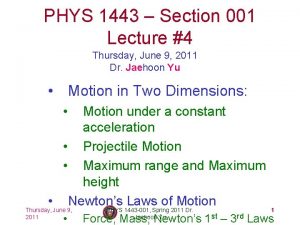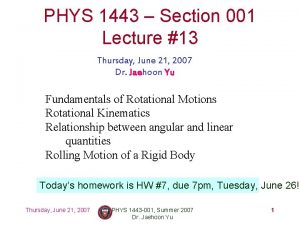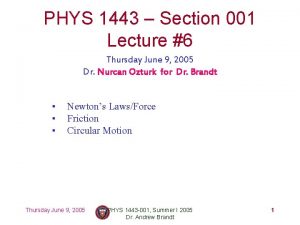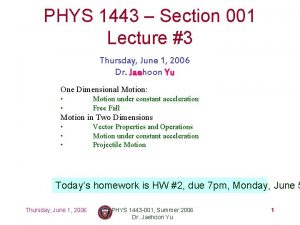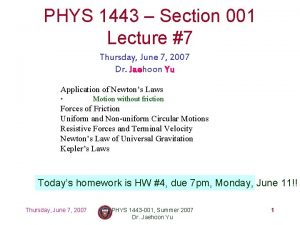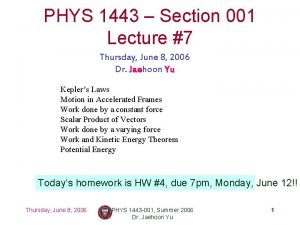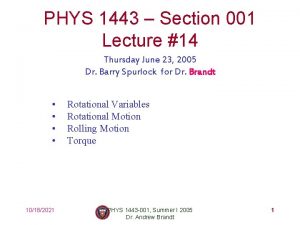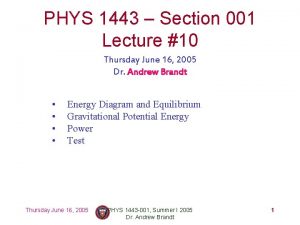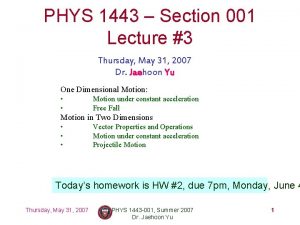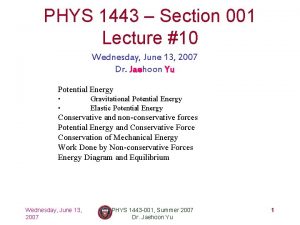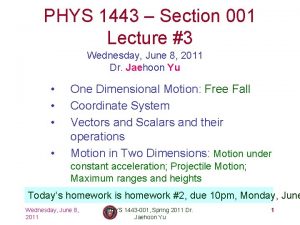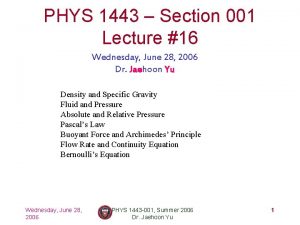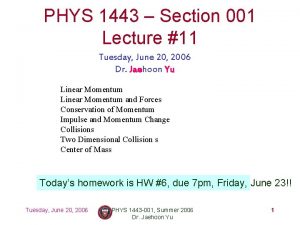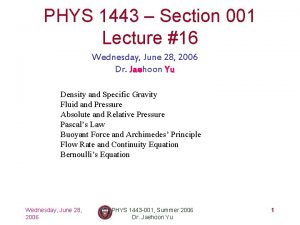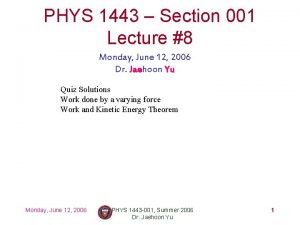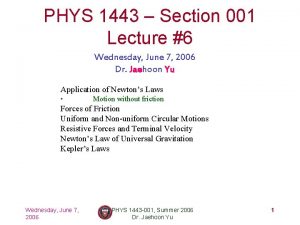PHYS 1443 Section 001 Lecture 3 Thursday June





















- Slides: 21

PHYS 1443 – Section 001 Lecture #3 Thursday, June 1, 2006 Dr. Jaehoon Yu One Dimensional Motion: • • Motion under constant acceleration Free Fall Motion in Two Dimensions • • • Vector Properties and Operations Motion under constant acceleration Projectile Motion Today’s homework is HW #2, due 7 pm, Monday, June 5 Thursday, June 1, 2006 PHYS 1443 -001, Summer 2006 Dr. Jaehoon Yu 1

Announcements • Reading assignment #2: Read section 2. 8 • Ten of you have registered for the homework – Seven of you submitted #1 – You MUST register and submit the homework to obtain 100% of the credit… • The class e-mail distribution list is available as of yesterday – Please go ahead and subscribe to the list • Phys 1443 -001 -summer 06 – Extra credit • 5 points if done by Tuesday, June 6 • 3 points if done by Thursday, June 8 Thursday, June 1, 2006 PHYS 1443 -001, Summer 2006 2

Acceleration Change of velocity in time (what kind of quantity is this • Average acceleration: analogs to • Instantaneous acceleration: analogs to • In calculus terms: The slope (derivative) of the velocity vector with respect to time or the change of slopes of position as a function of time Thursday, June 1, 2006 PHYS 1443 -001, Summer 2006 3

Acceleration vs Time Plot Thursday, June 1, 2006 PHYS 1443 -001, Summer 2006 4

Meanings of Acceleration • When an object is moving in a constant velocity (v=v 0), there is no acceleration (a=0) – Is there any acceleration when an object is not moving? • When an object speeds up as time goes on, (v=v(t) ), acceleration has the same sign as v. • When an object slows down as time goes on, (v=v(t) ), acceleration has the YES!! opposite sign as v. Thursday, June 1, 2006 PHYS 1443 -001, Summer 5 2006 • Is there acceleration if an object moves

One Dimensional Motion • Let’s start with the simplest case: acceleration is constant (a=a 0) • Using definitions of average acceleration and velocity, we can draw equation of motion (description of Solve for v xf If tf=t and ti=0 motion, position wrt time) For constant acceleration, simple numeric average If tf=t and ti=0 Solve for xf Resulting Equation of Motion becomes Thursday, June 1, 2006 PHYS 1443 -001, Summer 2006 6

Kinematic Equations of Motion on a Straight Line Under Constant Acceleration Velocity as a function of time Displacement as a function of velocities and time Displacement as a function of time, velocity, and acceleration Velocity as a function of Displacement and acceleration You may use different forms of Kinetic equations, depending on the information given to you for specific Thursday, June 1, problems!! 2006 PHYS 1443 -001, Summer 7 physical 2006

How do we solve a problem using a kinematic formula for constant acceleration? • Identify what information is given in the problem. – – Initial and final velocity? Acceleration? Distance? Time? • Convert the units of all quantities to SI units to be consistent. • Identify what the problem wants. • Identify which kinematic formula is appropriate and easiest to solve for what the problem wants. – Frequently multiple formulae can give you the answer for the quantity you are looking for. Do not just use any formula but use the one that can be easiest to solve. 1, 2006 PHYSthe 1443 -001, Summer wanted. • Thursday, Solve. June the equation for quantity 2006 8

Example 2. 11 Suppose you want to design an air-bag system that can protect the driver in a head-on collision at a speed 100 km/hr (~60 miles/hr). Estimate how fast the air-bag must inflate to effectively protect the driver. Assume the car crumples upon impact over a distance of about 1 m. How does the use of a seat belt help the driver? How long does it take for the car to come to a full stop? As long as it takes for it to crum The initial speed of the car is We also know that and Using the kinematic formula The acceleration is Thus the time for air-bag to deploy is Thursday, June 1, 2006 PHYS 1443 -001, Summer 2006 9

Free Fall • Free fall is a motion under the influence of gravitational pull (gravity) only; Which direction is a Down to the center of the Earth! freely falling object moving? – A motion under constant acceleration – All kinematic formulae we learned can be used to solve for falling motions. • Gravitational acceleration is inversely proportional to the distance between the object and the center of the earth • The magnitude of the gravitational acceleration is |g|=9. 80 m/s 2 on the surface of the Earth, most of the time. • The direction of gravitational acceleration is ALWAYS toward the center of the earth, which we normally call (-y); where up and directions Note down the negative sign!! Thursday, June 1, 2006 PHYS 1443 -001, Summer 10 are indicated with the variable “y” 2006

Example for Using 1 D Kinematic Equations on a Falling object Stone was thrown straight upward at t=0 with +20. 0 m/s initial velocity on the roof of a high building, g=-9. 80 m/s 2 What 50. 0 m is the acceleration in this motion? (a) Find the time the stone reaches at the maximum height. What is so special about the maximum height? V=0 Solve for t (b) Find the maximum height. Thursday, June 1, 2006 PHYS 1443 -001, Summer 2006 11

Example of a Falling Object cnt’d (c) Find the time the stone reaches back to its original heigh (d) Find the velocity of the stone when it reaches its original (e) Find the velocity and position of the stone at t=5. 00 s. Velocit y Position Thursday, June 1, 2006 PHYS 1443 -001, Summer 2006 12

Coordinate Systems • They make it easy to express locations or positions • Two commonly used systems, depending on convenience, are – Cartesian (Rectangular) Coordinate System • Coordinates are expressed in (x, y) – Polar Coordinate System • Coordinates are expressed in (r, q) • +y Vectors become a lot easier to express and compute How are Cartesian and Polar (x 1, y 1)=(r, q) y 1 coordinates related? r q O (0, 0) Thursday, June 1, 2006 x 1 +x PHYS 1443 -001, Summer 2006 13

Example Cartesian Coordinate of a point in the xy plane are (x, y)= (3. 50, -2. 50)m. Find the equivalent polar coordinates of this point. y q qs x r (-3. 50, -2. 50)m Thursday, June 1, 2006 PHYS 1443 -001, Summer 2006 14

Vector and Scalar Vector quantities have both magnitudes Force, gravitational acceleration, momentum (sizes) and directions Normally denoted in BOLD letters, F, or a letter with arrow on Their sizes or magnitudes are denoted with normal letters, F, or absolute values: Scalar quantities have magnitudes Energy, heat, mass, only weight Normally denoted in normal E Can be completely specified withletters, a value and its unit Both have units!!! Thursday, June 1, 2006 PHYS 1443 -001, Summer 2006 15

Properties of Vectors directio • Two vectors are the same ifsize their and the are the same, nos matter where ns they are on a coordinate system!! y D F A B x E Thursday, June 1, 2006 C PHYS 1443 -001, Summer 2006 Which ones are the same vectors? A=B=E= D Why aren’t the others? C: The same magnitude but opposite direction: C=-A: A C=-A: negative F: The same vector direction but 16 different magnitude

Vector Operations • Addition: – Triangular Method: One can add vectors by connecting the head of one vector to the tail of the other (head-to-tail) – Parallelogram method: Connect the tails of the two vectors and extend – Addition is commutative: Changing order of operation does not affect the results A+B=B+A, A+B=B+A A+B+C+D+E=E+C+A+B+D A A+B B A = B A A+B OR B A+B A • Subtraction: – The same as adding a negative vector: A - B = A + (-B) A A-B -B Since subtraction is the equivalent to adding a negative vector, subtraction is also commutative!!! • Multiplication by a scalar is increasing the magnitude A, B=2 AJune 1, 2006 Thursday, A PHYS 1443 -001, Summer 2006 B=2 A 17

Example for Vector Addition A car travels 20. 0 km due north followed by 35. 0 km in a direction 60. 0 o west of north. Find the magnitude and direction of resultant displacement. Bsinq N B 60 o Bcosq r q 20 A E Thursday, June 1, 2006 PHYS 1443 -001, Summer 2006 Find other ways to solve this problem… 18

Components and Unit Vectors Coordinate systems are useful in expressing vectors in their components y Components (+, +) Ay (Ax, Ay) } Magnitude A (-, +) } q (-, -) (+, -) Ax x • Unit vectors are dimensionless vectors whose magnitude are exactly 1 • Unit vectors are usually expressed in i, j, k or • Vectors So the above can be expressed using components and unit vectors A can be A Thursday, written. June as 1, 2006 PHYS 1443 -001, Summer 2006 19

Examples of Vector Operations Find the resultant vector which is the sum of A=(2. 0 i+2. 0 j) and B =(2. 0 i-4. 0 j) Find the resultant displacement of three consecutive displacements: d 1=(15 i+30 j +12 k)cm, d 2=(23 i+14 j 5. 0 k)cm, and d 3=(-13 i+15 j)cm Magnitu de Thursday, June 1, 2006 PHYS 1443 -001, Summer 2006 20

Displacement, Velocity, and Acceleration in 2 -dim • Displaceme nt: • Average Velocity: How is each of these • Instantaneou quantities s Velocity: defined in 1 D? • Average Acceleration • Instantaneou s Acceleration: Thursday, June 1, 2006 PHYS 1443 -001, Summer 21 2006
 Purdue physics 241
Purdue physics 241 01:640:244 lecture notes - lecture 15: plat, idah, farad
01:640:244 lecture notes - lecture 15: plat, idah, farad Uiuc physics 102
Uiuc physics 102 Uiuc physics 101
Uiuc physics 101 Ucsd physics courses
Ucsd physics courses How to calculate experimental uncertainty
How to calculate experimental uncertainty Phys 172
Phys 172 Single slit envelope
Single slit envelope Http //vsg.quasihome.com
Http //vsg.quasihome.com Phys 212 equation sheet
Phys 212 equation sheet Phys 398 uiuc
Phys 398 uiuc Coloumb units
Coloumb units Att phys medical abbreviation
Att phys medical abbreviation Plur root words
Plur root words Mastering physics login
Mastering physics login Phys 214
Phys 214 Particl clicker
Particl clicker Phys 121 umd
Phys 121 umd Catch the excitement
Catch the excitement Jones vectors
Jones vectors Uiuc phys 101
Uiuc phys 101 Phys 225
Phys 225



